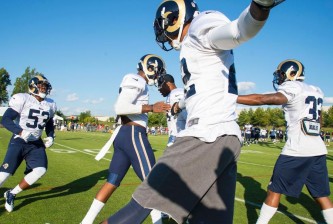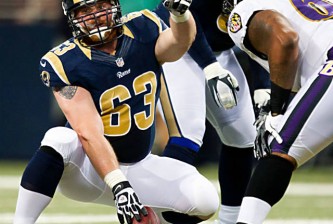This year’s draft is going to be unique for a number of reasons, and the Rams — holding the first pick of the second round — are in a unique position to be able to take advantage. The prospect of an uncapped year, perhaps the last year without a cap on rookie contracts, and the possibility of an NFL strike next season, has driven an exceptional amount of undergraduate talent into this year’s draft, making it one of the deepest and most talent-stocked draft in the last twenty years.
But the bulk of that talent is still raw. There are a handful of guys who are considered top-five talents (Sam Bradford is sort of elbowed in there as the most-media-polished quarterback) in DT Ndamukong Suh, DT Gerald McCoy, S Eric Berry, OT Russell Okung, QB Jimmy Clausen, CB Joe Haden, and an outside nod to best-in-classes RB CJ Spiller and WR Dez Bryant (if you ignore the warning signs). The rest form a vast middle section of intriguing and potentially useful players that spreads well past the end of Thursday’s prime time selections.
I think I’m more excited for the 2nd rd of this draft than I am for the 1st. There are going to be a TON of impact guys available.
The fact that the first pick of the second round is separated by a sleepless night of calculations and teeth-gnashing by GMs across the league just amplifies the potential value of the pick. Everyone across the NFL will be focused on who’s left, the player(s) who dropped unexpectedly out of the first round. Could be players with question marks about their desire, like DE Carlos Dunlap, or players with question marks about their health, like TE Rob Gronkowski. One thing is for sure, there will be plenty of nice talent available that just didn’t fill needs. QB Colt McCoy, almost universally mocked to be the top player available in Round 2, certainly fits into this category. More on him later.
The Rams, holding the first pick of the second day, are in a nice position to cash in. But here is where some interesting Moneyball theory comes into play. What is the #33 pick worth? And can the Rams set, or even re-set that market price?
There is growing sentiment that the first overall pick is worth nowhere near the trade bounty that the NFL Draft Value Chart (now fifteen years old and as hard-set as Jimmy Johnson’s hair) has assigned to it. In fact, some recent research suggests that, in fact, the first pick in the draft returns pretty poor value compared to the late first round and early second round.
As it turns out, however, the draft does not play the Robin Hood role particularly well. Indeed, I have written a paper, recently revised, on this subject with Cade Massey, a professor at the Yale School of Management. We found that the teams choosing early in the draft generally don’t, in fact, get the players that provide the most value per dollar. Our paper is titled “The Loser’s Curse” because we discovered that the first pick in the draft is, on average, the least valuable in the entire first round.
Evidence of recent Rams deals — and the teams that the Rams have been dealing with, notably the Eagles, Giants and Falcons — suggests that Billy Devaney and company fall somewhat on the traditional side. But the calm and efficient manner with which Kevin Demoff has dispatched contracts, and the relative openness with which Devaney has dealt with fans, suggests that perhaps there is more creativity and cleverness than meets the eye here.
The problem with the wide base of available impact talent is that the #33 pick isn’t necessarily worth that much more than the #34, #35, or #36 … especially as team’s draft boards start to fragment along need-based lines. If the Rams take Sam Bradford (as is still widely expected), then everyone and their brother knows that neither they nor the Lions at pick #34 will take Colt McCoy. Tampa Bay at #35 is a wildcard, Kansas City at #36 even more so. So a team like Cleveland, who could have an urgent desire for McCoy’s services, has their pick of trade partners. However, the Rams could have strong interest in a player like RBs Jonathan Dwyer or Jahvid Best (assuming one of the two drops), and draw a run-hungry team like the Chiefs or Eagles (pick #37) out of their shells. Conversely, the availability of WRs Arrelious Benn or Demaryius Thomas could entice the Bucs, Dolphins, Bills or Giants into a frenzy; either of DTs Jared Odrick and Brian Price, or DEs Carlos Dunlap and Jerry Hughes could infatuate a number of rush-poor teams like the Chiefs or Jaguars.
The Rams have been noticeably quiet, though, while Detroit has made headlines with their aggressive deals — the latest a three-way gem with the Eagles and Broncos, dealing away the fading-but-productive OLB Ernie Sims, and landing TE Tony Scheffler and a seventh-round draft pick. (It will be interesting to compare the production of Scheffler versus our own Brandon Gibson, who was returned with an Eagles’ fifth-round draft pick for a similarly fading-but-productive OLB.)
To my mind, this suggests that Detroit’s GM, Martin Mayhew, has already established the coveted “horse trader” status that makes him the first phone to call for any team interested in moving up into the upper echelon of Round 2.
The trade lines, usually notoriously cold in the NFL, have been heating up. And if Devaney and company can’t turn the #1 and #33 picks into at least three good players, I have to wonder whether this draft can possibly score high for the Rams.






















